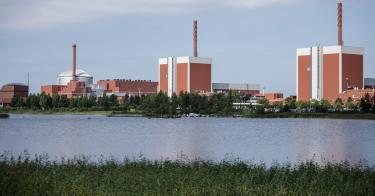Even long-time opponents of nuclear power are starting to see the light. Finland’s Green Party, for example, recently voted to support nuclear energy, including a demand to streamline the approval process for small modular reactors.
With Russia cutting off natural gas deliveries, the Finns have come to realize that nuclear energy provides substantial environmental, cost and security benefits.
Nuclear energy offers tremendous environmental advantages. Unlike conventional fossil fuels, it has almost zero emissions. It also requires a smaller footprint than solar or wind. According to one study, nuclear power requires just over 12 acres per megawatt of electricity produced. Solar requires more than 43 acres; wind over 70.
Although currently expensive to build, nuclear plants are inexpensive to operate: fuel accounts for only about 20% of a nuclear plant’s operating costs. And those costs are more stable over time, an especially appealing feature in times of inflation.
>>> Why Climate Activists and Environmentalists Should Support Nuclear Power
From a security standpoint, nuclear fuel is widely available and purchased years in advance.
Nuclear waste is a problem today, but it need not be. There are safe and effective methods for managing nuclear waste. The real problem is political mismanagement, which has blocked the safe storage of waste for decades.
Spent nuclear fuel is a solid product, not a sludgy witch’s brew. And there isn’t a lot of it. All of the spent fuel ever produced in the U.S. could fit on a single football field stacked 10 yards high.
In addition, spent fuel rods are recyclable. Over 90% of the energy potential in fresh nuclear fuel remains after it has run its course through a reactor. That means it can be used again.
Interestingly, France has integrated this process into its nuclear industry, and some advanced reactors may even be able to reuse “nuclear waste” as fuel.
So, why is the United States not following suit? It goes back to the 1982 Nuclear Waste Policy Act, which officially put Washington in charge of the process.
Predictably, Washington fumbled its obligations under the act by not fulfilling the law’s requirement to build a waste repository at Yucca Mountain. That has been costly. The General Accounting Office estimated last year that the Energy Department’s failure to meet its responsibility will cost taxpayers $40 billion — $8.6 billion of which has already been paid to utilities doing the government’s job.
Essentially, the U.S. nuclear business can’t move forward in any market-rational way until the waste issue is resolved. That’s because by taking the responsibility away from the nuclear industry, the federal government has undermined the incentive for the private sector to develop and commercialize new technologies and methods to manage the fuel cycle more efficiently.
Finland took a different route. They put waste producers in charge of managing waste. And now, with incentives properly aligned, unlike in the United States, Finland’s nuclear industry is building a nuclear waste repository.
What about the horror stories: Chernobyl, Three Mile Island and Fukushima?
Set Chernobyl aside. It was a flawed reactor design, and the Soviet Union had no respect for safe operations. That accident couldn’t happen in the United States.
>>> A Proactive Environmental Policy Agenda for Congress and the Administration
Regarding Three Mile Island and Fukushima, remember that no one died or even got radiation sickness from either accident. However, lessons learned from both events have resulted in greater safety overall.
While no accident should be taken lightly, the fact remains that nuclear power has an excellent safety record. It has been providing electricity since the late 1950s, and more than 440 commercial reactors are operating globally today.
Isolated incidents should not deter us from progress. Society has learned from these challenges, and companies have developed safer technologies and procedures. We should move forward in a way that can better the lives of all our citizens.
That is what Finland is doing with its nuclear energy program. The United States would do well to see what’s working in Finland and apply that here.
We once led the world in nuclear power. We can do it again.
This piece originally appeared in The Washington Times




